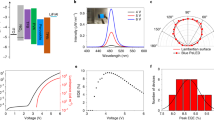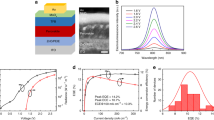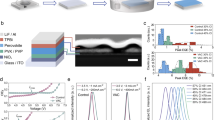Abstract
Perovskite light-emitting diodes (LEDs) show promises for next-generation displays owing to their excellent luminescent properties and low cost. Despite substantial progress with green- and red-emitting devices, the development of efficient blue perovskite LEDs has lagged behind. Here we demonstrate efficient blue perovskite LEDs based on a mixed two-dimensional–three-dimensional perovskite and a multifunctional ionic additive that enables control over the reduced-dimensional phases, non-radiative recombination channels and spectral stability. We report a series of devices that emit efficient electroluminescence from mixed bromide/chloride quasi-three-dimensional regions, with external quantum efficiencies of up to 21.4% (at a luminance of 22 cd m–2 and emission peak at 483 nm), 13.2% (at a luminance of 2.0 cd m–2 and emission peak at 474 nm) and 7.3% (at a luminance of 6 cd m–2 and emission peak at 464 nm). Devices show a nearly 30-fold increase in operational stability compared with control LEDs, with a half-lifetime of 129 min at an initial luminance of 100 cd m–2. Our findings demonstrate the performance of blue perovskite LEDs close to that of state-of-the-art blue organic LEDs and inorganic quantum dot LEDs and provide a new approach to design multifunctional molecules to boost the performance of perovskite optoelectronic devices.
This is a preview of subscription content, access via your institution
Access options
Access Nature and 54 other Nature Portfolio journals
Get Nature+, our best-value online-access subscription
$29.99 / 30 days
cancel any time
Subscribe to this journal
Receive 12 print issues and online access
$209.00 per year
only $17.42 per issue
Buy this article
- Purchase on Springer Link
- Instant access to full article PDF
Prices may be subject to local taxes which are calculated during checkout




Similar content being viewed by others
Data availability
The main data that support the findings of this study are available within the Article and its Supplementary Information. Related research results are available from the corresponding authors upon reasonable request.
References
Tan, Z.-K. et al. Bright light-emitting diodes based on organometal halide perovskite. Nat. Nanotechnol. 9, 687–692 (2014).
Cho, H. et al. Overcoming the electroluminescence efficiency limitations of perovskite light-emitting diodes. Science 350, 1222–1225 (2015).
Yuan, M. et al. Perovskite energy funnels for efficient light-emitting diodes. Nat. Nanotechnol. 11, 872–877 (2016).
Protesescu, L. et al. Nanocrystals of cesium lead halide perovskites (CsPbX3, X = Cl, Br, and I): novel optoelectronic materials showing bright emission with wide color gamut. Nano Lett. 15, 3692–3696 (2015).
Xiao, Z. et al. Efficient perovskite light-emitting diodes featuring nanometre-sized crystallites. Nat. Photon. 11, 108–115 (2017).
Cao, Y. et al. Perovskite light-emitting diodes based on spontaneously formed submicrometre-scale structures. Nature 562, 249–253 (2018).
Lin, K. et al. Perovskite light-emitting diodes with external quantum efficiency exceeding 20 per cent. Nature 562, 245–248 (2018).
Hassan, Y. et al. Ligand-engineered bandgap stability in mixed-halide perovskite LEDs. Nature 591, 72–77 (2021).
Liu, X.-K. et al. Metal halide perovskites for light-emitting diodes. Nat. Mater. 20, 10–21 (2021).
Yang, X. et al. Efficient green light-emitting diodes based on quasi-two-dimensional composition and phase engineered perovskite with surface passivation. Nat. Commun. 9, 570 (2018).
Kong, L. et al. Smoothing the energy transfer pathway in quasi-2D perovskite films using methanesulfonate leads to highly efficient light-emitting devices. Nat. Commun. 12, 1246 (2021).
Wang, N. et al. Perovskite light-emitting diodes based on solution-processed self-organized multiple quantum wells. Nat. Photon. 10, 699–704 (2016).
Kim, Y. et al. Comprehensive defect suppression in perovskite nanocrystals for high-efficiency light-emitting diodes. Nat. Photon. 15, 148–155 (2021).
Chiba, T. et al. Anion-exchange red perovskite quantum dots with ammonium iodine salts for highly efficient light-emitting devices. Nat. Photon. 12, 681–687 (2018).
Xu, W. et al. Rational molecular passivation for high performance perovskite light-emitting diodes. Nat. Photon. 13, 418–424 (2019).
Jiang, Y. et al. Reducing the impact of Auger recombination in quasi-2D perovskite light-emitting diodes. Nat. Commun. 12, 336 (2021).
Uoyama, H., Goushi, K., Shizu, K., Nomura, H. & Adachi, C. Highly efficient organic light-emitting diodes from delayed fluorescence. Nature 492, 234–238 (2012).
Cao, L., Klimes, K., Ji, Y., Fleetham, T. & Li, J. Efficient and stable organic light-emitting devices employing phosphorescent molecular aggregates. Nat. Photon. 15, 230–237 (2021).
Ai, X. et al. Efficient radical-based light-emitting diodes with doublet emission. Nature 563, 536–540 (2018).
Dai, X. et al. Solution-processed, high-performance light-emitting diodes based on quantum dots. Nature 515, 96–99 (2014).
Shen, H. et al. Visible quantum dot light-emitting diodes with simultaneous high brightness and efficiency. Nat. Photon. 13, 192–197 (2019).
Won, Y. et al. Highly efficient and stable InP/ZnSe/ZnS quantum dot light-emitting diodes. Nat. Photon. 575, 634–638 (2019).
Meng, T. et al. Ultrahigh-resolution quantum-dot light-emitting diodes. Nat. Photon. 16, 297–303 (2022).
Chu, Z. et al. Large cation ethylammonium incorporated perovskite for efficient and spectra stable blue light-emitting diodes. Nat. Commun. 11, 4165 (2020).
Karlsson, M. et al. Mixed halide perovskites for spectrally stable and high-efficiency blue light-emitting diodes. Nat. Commun. 12, 361 (2021).
Liu, Y. et al. Efficient blue light-emitting diodes based on quantum-confined bromide perovskite nanostructures. Nat. Photon. 13, 760–764 (2019).
Li, Z. et al. Modulation of recombination zone position for quasi-two-dimensional blue perovskite light-emitting diodes with efficiency exceeding 5%. Nat. Commun. 10, 1027 (2019).
Jiang, Y. et al. Synthesis-on-substrate of quantum dot solids. Nature 612, 679–682 (2022).
Kondo, Y. et al. Narrowband deep-blue organic light-emitting diode featuring an organoboron-based emitter. Nat. Photon. 13, 678–682 (2019).
Sun, J. et al. Exceptionally stable blue phosphorescent organic light-emitting diodes. Nat. Photon. 16, 212–218 (2022).
Kim, T. et al. Efficient and stable blue quantum dot light-emitting diode. Nature 586, 385–389 (2020).
Yuan, S. et al. Efficient and spectrally stable blue perovskite light-emitting diodes employing a cationic π-conjugated polymer. Adv. Mater. 45, 2103640 (2021).
Jiang, Y. et al. Spectra stable blue perovskite light-emitting diodes. Nat. Commun. 10, 1868 (2019).
Xing, J. et al. Color-stable highly luminescent sky-blue perovskite light-emitting diodes. Nat. Commun. 9, 3541 (2018).
Wang, C. et al. Dimension control of in situ fabricated CsPbClBr2 nanocrystal films toward efficient blue light-emitting diodes. Nat. Commun. 11, 6428 (2020).
Tao, Y. et al. Resonance-activated spin-flipping for efficient organic ultralong room-temperature phosphorescence. Adv. Mater. 44, 1803856 (2018).
Jiang, H. et al. Organic resonance materials: molecular design, photophysical properties, and optoelectronic applications. J. Phys. Chem. Lett. 18, 7739–7754 (2020).
Swartz, W., Ruff, J. & Hercules, D. X-ray photoelectron spectroscopic study of some bis(triphenylphosphine)iminium salts. J. Am. Chem. Soc. 15, 5227–5229 (1972).
Abdi-Jalebi, M. et al. Maximizing and stabilizing luminescence from halide perovskites with potassium passivation. Nature 555, 497–501 (2018).
Herberholz, R., Igalson, M. & Schock, H. W. Distinction between bulk and interface states in CuInSe2/CdS/ZnO by space charge spectroscopy. J. Appl. Phys. 83, 318–325 (1998).
Frisch, M. J. et al. Gaussian 16 Rev. B.01 Release Notes (2016).
Giannozzi, P. et al. QUANTUM ESPRESSO: a modular and open-source software project for quantum simulations of materials. J. Phys.: Condens. Matter 21, 395502 (2009).
Giannozzi, P. et al. Advanced capabilities for materials modelling with Quantum ESPRESSO. J. Phys.: Condens. Matter 29, 465901 (2017).
Perdew, J. P. et al. Restoring the density-gradient expansion for exchange in solids and surfaces. Phys. Rev. Lett. 100, 136406 (2008).
Garrity, K. F., Bennett, J. W., Rabe, K. M. & Vanderbilt, D. Pseudopotentials for high-throughput DFT calculations. Comput. Mater. Sci. 81, 446–452 (2014).
Monkhorst, H. J. & Pack, J. D. Special points for Brillouin-zone integrations. Phys. Rev. B 13, 5188–5192 (1976).
Acknowledgements
This work was supported by funding from the USTC Research Funds of the Double First-Class Initiative and the National Natural Science Foundation of China (NSFC) (grant agreement no. 52103242). This work was partially carried out at the USTC Center for Micro and Nanoscale Research and Fabrication. The numerical calculations in this paper were performed on the supercomputing system at the Supercomputing Center of the University of Science and Technology of China. S.Y. acknowledges financial support from the China Postdoctoral Science Foundation (grant agreement no. 2021M703115) and Natural Science Foundation of Anhui Province (grant agreement no. 2208085QE133). L.D. acknowledges support from the China Scholarship Council, Cambridge Trust and the European Research Council (ERC; European Union’s Horizon 2020, PEROVSCI 957513). Y.S. acknowledges support from the China Scholarship Council and Cambridge Trust. F.A. acknowledges funding from the ERC under the European Union’s Horizon 2020 research and innovation programme (grant agreement no. 670405). Y.L. acknowledges support from Simons Foundation (grant 601946) and A*STAR under its Young Achiever Award. Y.-H.Z. and L.-S.L. acknowledge funding from the Natural Science Foundation of China (grant agreement nos. 51773141, 61961160731 and 51821002). S.D.S. acknowledges funding from the Royal Society and Tata Group (UF150033). R.H.F. acknowledges support from the EPSRC (EP/M01083X/1 and EP/M005143/1) and the ERC under the European Union’s Horizon 2020 research and innovation programme (grant agreement no. 670405). This work was supported by EPSRC grants EP/R023980/1, EP/M01083X/1 and EP/M005143/1. C.D., X.L. and Y.Q. acknowledge funding support from the Energy Materials and Surface Sciences Unit of the Okinawa Institute of Science and Technology Graduate University, the OIST R & D Cluster Research Program and the OIST Proof of Concept (POC) Program. X.T. and C.A. acknowledge support from the Japan Science and Technology Agency (JST) CREST (no. JPMJCR22B3) and Japan Society for the Promotion of Science (JSPS) KAKENHI (no. 23H05406). X.T. acknowledges support from JSPS KAKENHI (no. 22K20536).
Author information
Authors and Affiliations
Contributions
The project was conceived and designed by L.-S.C. and S.Y. S.Y. fabricated the efficient perovskite LEDs, characterized the device performances and obtained the materials characteristics under the supervision of L.-S.C. L.D. conducted the TA experiments and analysed the results under the supervision of S.D.S. Y.S. prepared the perovskite films and assisted with the photophysical measurements and data analysis, as well as cross-checked the LED measurements under the supervision of N.C.G. F.A. participated in the discussion and edited the manuscript. Y.-H.Z. prepared the samples for FTIR measurements under the supervision of L.-S.L. R.-Z.A. and Z.-F.Y. prepared the perovskite films and assisted with the NMR measurements under the supervision of L.-S.C. Y.L. performed the theoretical calculations. C.C. conducted the FIB, STEM and TEM measurements. C.D. analysed the TEM results under the supervision of Y.Q. X.T. performed the streak camera measurements under the supervision of C.A. C.D. carried out the ToF-SIMS measurements. H.-B.K. conducted the XRD measurements. K.C. helped the analysis of ultrafast PL results. X.L. prepared the perovskite precursors and assisted in performing the XRD measurements under the supervision of Y.Q. and Y.Z. L.-S.C. and S.D.S. supervised the work and assisted in the data analysis. S.Y., L.D., S.D.S., L.-S.C. and R.H.F. wrote the manuscript. All authors discussed the results and commented on the manuscript.
Corresponding authors
Ethics declarations
Competing interests
The authors declare no competing interests.
Peer review
Peer review information
Nature Photonics thanks Xuyong Yang and the other, anonymous, reviewer(s) for their contribution to the peer review of this work.
Additional information
Publisher’s note Springer Nature remains neutral with regard to jurisdictional claims in published maps and institutional affiliations.
Supplementary information
Supplementary Information
Supplementary Figs. 1–26, Notes 1 and 2 and Table 1.
Rights and permissions
Springer Nature or its licensor (e.g. a society or other partner) holds exclusive rights to this article under a publishing agreement with the author(s) or other rightsholder(s); author self-archiving of the accepted manuscript version of this article is solely governed by the terms of such publishing agreement and applicable law.
About this article
Cite this article
Yuan, S., Dai, L., Sun, Y. et al. Efficient blue electroluminescence from reduced-dimensional perovskites. Nat. Photon. (2024). https://doi.org/10.1038/s41566-024-01382-6
Received:
Accepted:
Published:
DOI: https://doi.org/10.1038/s41566-024-01382-6



